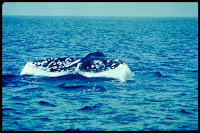
To figure out just how dense and diverse, a team of researchers sank a dead 30-ton grey whale and followed the progress of its decomposition over several years.
(Image: A live gray whale, sounding. Credit: NOAA.)
The whale was dropped to water a mile deep. The researchers visited the whale remains repeatedly over 6 to 7 years, using a remotely operated undersea vehicle.
They reported the results under the title “Biogeochemistry of a deep-sea whale fall: sulfate
reduction, sulfide efflux and methanogenesis,” in the Marine Ecology Progress Journal (Vol. 382: 1–21, 2009; doi: 10.3354/meps07972). http://www.int-res.com/articles/feature/m382p001.pdf
The authors include University of Hawai'i Department of Oceanography scientists Craig R. Smith, Angelo Bernardino and Angelos Hannides, along with Tina Treude, Frank Wenzhofer, Erin Carney, Martin Kruger and Antje Boetius of Germany's Max Planck Institute for Marine Microbiology.
The term “whale fall” is used for whales that die and rain down on the ocean floor. The team identified four stages of decomposition.
The first is one where swimming scavengers feed on soft tissue. The creatures include sharks, hagfishes and amphipods, which are shrimp-like crustaceans.
The second phase is called the enrichment-opportunistic phase, in which a comparatively few species feed on what's left of the scattered remains after the flesh-eaters have taken their portion.
Third, microbes attack the organic compounds in bones, producing hydrogen sulfide, which in turn feeds another group of deep sea life forms. This is the stage that the paper studies most closely.
Finally, in what the paper calls the reef stage, the cluster of bones becomes habitat, a place for a range of deep sea animals to hide.
The appearance of a whale carcass creates a center of fertility on the ocean floor. It prompts the arrival of a range of species, creates habitat for things like mats of bacteria, and increases the nutrient levels in the seafloor sediment immediately around the carcass.
Some of the life forms are the same ones that are found at sulfur-rich hot water vents on the ocean floor.
© Jan TenBruggencate 2009
Saturday, July 25, 2009
Whale Fall: energizing life on the seafloor
Posted by Jan T at 9:12 AM
Labels: Fisheries, Marine Issues, Oceanography, Reefs, Sharks, Whales
Subscribe to:
Post Comments (Atom)









No comments:
Post a Comment